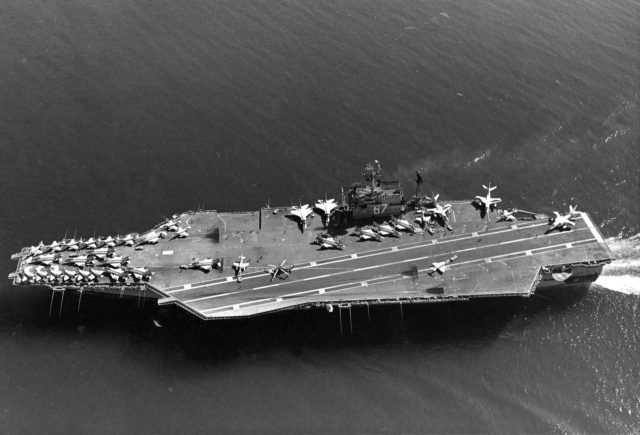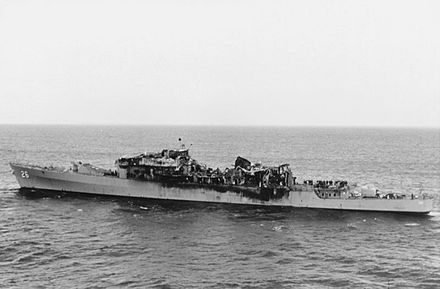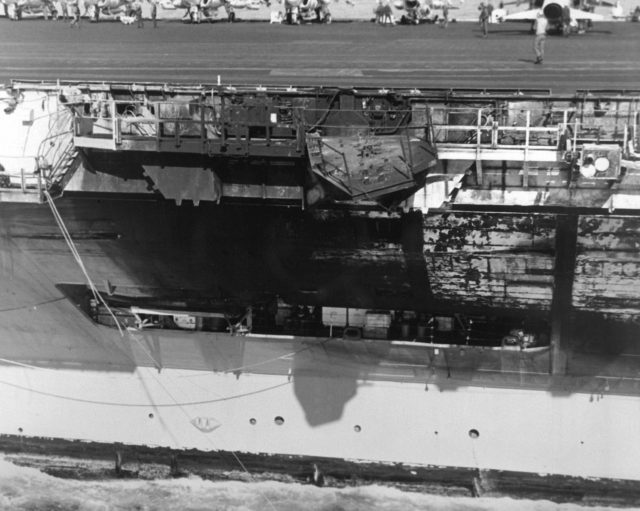Well the flare flew through the open cargo hatch and hit somebody's fart sack and caught fire, well they couldn't get the fire out and it really started to burn especially with the stuff they had in the track. Well this track was the NBC(Nuclear, Biological, Chemical) track and it was loaded with several M8 chemical alarms...well the track caught fire and the aluminum started burning and that was it for the track. it left the next day in a loboy wrapped like a baggie, the M8 Chemical alarms had radioactive material in it and the hulk was radioactive. We thought it was funny because we were no longer the donkey for the ARTEP. We had some people set a tent on fire with the pot belly stove, the day before so we were assured of the "wherethefauckarewe" award but 4/16 screwed the pooch worse than we did with the radioactive track.
The USS Belknap was the first ship in a new group of guided missile cruisers. She was laid down in 1962 and launched in 1963.
She was reclassified after a major accident occurred in 1975 when she collided with the aircraft carrier USS John F. Kennedy.
The accident killed seven crew on the cruiser and one on the aircraft carrier and severely damaged the ship. She remained in service for another 20 plus years before being decommissioned. It was widely believed the accident resulted in the US Navy changing the way they built ships.
On the night of November 22, 1975, the two ships were located about 70 miles off the coast of Sicily, Italy, where they were performing night-time flying exercises

As the two ships collided, there were reports that the aircraft carrier’s flight deck caused the Belknap’s mast, as well as its stack, to fall onto the ship. One of the fuel lines on the carrier just beneath the flight deck was severed during the collision and spilled gas over the Belknap. The resulting fires quickly took hold of the ship.
The Belknap’s crew worked on containing the blaze. The guided missile destroyer the Claude V. Ricketts and the destroyer Bordelon went to assist. They aimed their fire hoses at parts of the Belknap her crew could no longer access.
The Claude V. Ricketts moved in to get injured men off the ship. The fire was spreading rampantly, setting fire to everything, including ammunition. With shrapnel raining down from the explosions and the tremendous fire; it was a dramatic scene.
As the rescue continued, some men did not want to leave their ship and stayed to fight the fire. It took more than two hours to get the fire under control. By the time it was, the damage was extensive.
When the cruiser had been built, aluminum was used for the superstructure. Unfortunately, aluminum melts at extreme temperatures. Part of the ship had been destroyed leaving a gaping hole.

The event earned the carrier the nicknames “Can Opener” and “Jack the Tin Can Killer”.
It was believed that if the Belknap‘s superstructure had been built with steel, the damage would not have been as bad. Not long after this incident, the US Navy made the decision to switch to all-steel superstructures. While it was suggested the change was as a result of the Belknap-Kennedy collision, the New York Times wrote an article in 1987 stating the change was made due to cracking in several aluminum superstructures.

Post-Crash
Once the dust had cleared, the USS Belknap was taken to an ammunition depot where it was stripped of any remaining ammunition. The crew was shifted to the ammunition ship Mount Baker until they could be placed somewhere else or reassigned.Belknap was converted to a flagship by Norfolk Naval Shipyard from May 1985 to February 1986. This conversion work entailed building out the superstructure forward to just aft of the missile launcher and three decks up to add flag spaces (accommodation and office), and additional communications gear. In addition, the helicopter hangar aft was turned into accommodation spaces for flag staff and a small detachment of Marines. After this conversion she sailed to Italy and became Sixth Fleet flagship, relieving Coronado.On 27 May 1989, she participated in a naval parade with ships from 10 countries at Barcelona.
Belknap played a role in the Malta Summit between US President George H. W. Bush and Soviet Leader Mikhail Gorbachev on 2 December and 3 December 1989. The US President, along with his advisers, James Baker, John Sununu and Brent Scowcroft, had their sleeping quarters aboard Belknap, whereas the Soviet delegation used the missile cruiser Slava. The ships were anchored in a roadstead off the coast of Marsaxlokk. Stormy weather and choppy seas resulted in some meetings being cancelled or rescheduled, and gave rise to the moniker the "Seasick Summit" among international media. In the end, the meetings took place aboard Maxsim Gorkiy, a Soviet cruise ship anchored in the harbor at La Valletta. Engineers from the Navy Ship Systems Engineering Station devised a mooring arrangement for this event, and despite the worst-case 100-year storm event, Belknap held its ground using emergency operating procedures as outlined by the engineers.
Belknap was decommissioned and stricken from the Naval Vessel Register on 15 February 1995 and sunk as a target on 24 September 1998.


That was a helluva mess... Lucky only the few folks died, it could have been VERY much worse! HMS Sheffield learned the fallacy of aluminum during the Falklands War too!
ReplyDeleteHey old NFO;
DeleteI forgot about the sheffield and the Argentinian exocet missile.